12 top plants for a brilliant winter container garden display
A winter container garden display can give the garden such a lift.
You can enjoy winter pots in the front garden every time you come home. And just a few pots near the house in the back garden can give your back garden focus and structure at a time when things can look quite shaggy.
So garden designer and baking influencer Jane Beedle and I set out to find the best plants for winter pots.
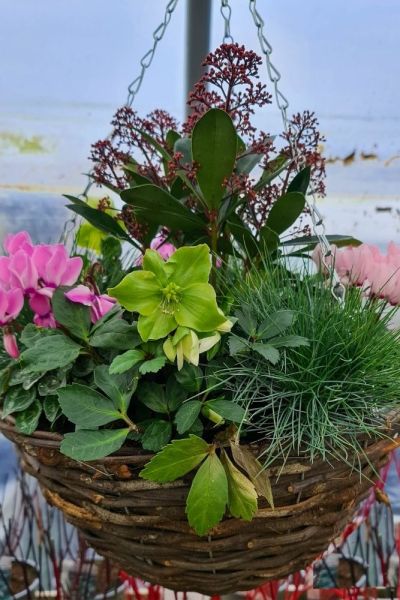
This hanging basket is full of plants you can plant out in your garden when you want to change the pots. Clockwise from left: pink hardy cyclamen, skimmia, festuca glauca and hellebore.
If you prefer to watch a video, see evergreens for winter pots here.
Reduce waste – use plants that can go in the garden later
All plants can grow in pots. So you can buy very small, young shrubs and perennials for your winter pots, hanging baskets and window boxes. They won’t grow much in winter so you can often keep them in your summer planters.
They will then grow in the summer, but you can often get a second winter out of them before they grow too big. At that point, you can plant them out in the garden.
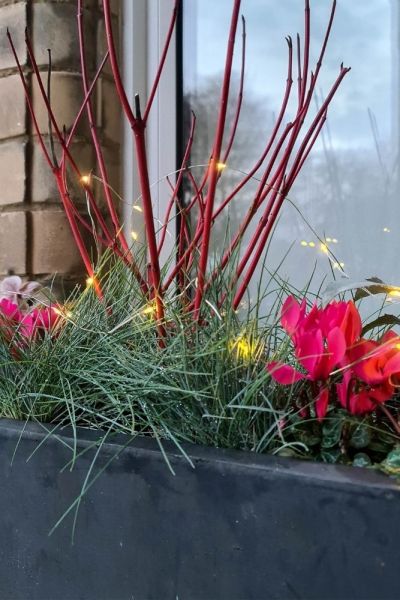
Jane starts her window box and planters by placing a tall plant at the centre. Here she chose a cornus (‘Cornus alba ‘Sibirica’) as a central plant. When the cornus is in leaf in the summer, it would be too large for most planters, but their red branches look wonderful and elegantly airy in winter.
12 good winter container garden plants which also grow in your garden
Here is our pick of the best evergreen plants which can start in your winter containers and then grow on in your garden:
Conifers – many varieties. Available as ‘ground cover’ or to add height and structure.
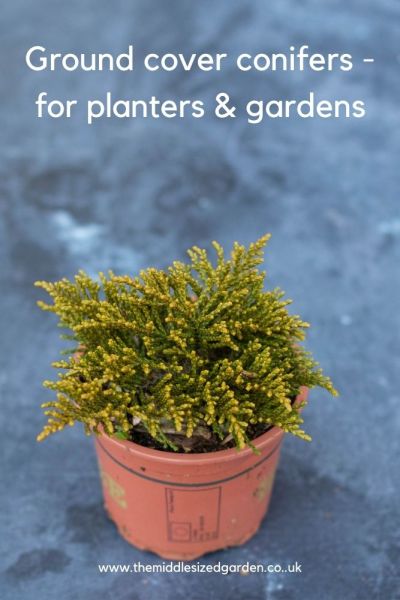
This is a ground cover conifer, which would work equally well in a planter or in the garden. Check the ultimate height as some tiny plants can grow very tall. There are thousands of conifer varieties, with some wonderful shapes and colours. See how conifers can transform your garden here.
Cyclamen – plant hardy varieties outside in shady spots
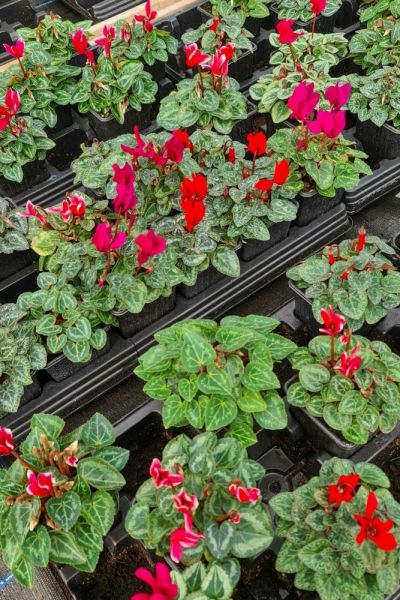
Hardy cyclamen are one of the best colourful flowers for winter container gardens. Available in pink, red, purple and white, they can be planted out in a shady part of the garden and will often spread.
Ferns – many varieties, choose evergreen for winter container gardens
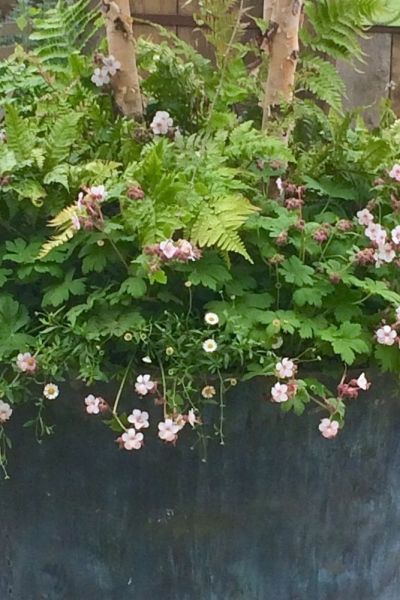
Ferns in a pot with a silver birch and Geranium macrorrhizum. There are thousands of different types of ferns, so check they’re evergreen for winter containers and also whether they’ll prefer sun or shade when planted out. The geraniums won’t flower in winter, so you would probably need to switch around the plants for the cooler months.
Festuca glauca (sedge) available in blue/grey and bright green
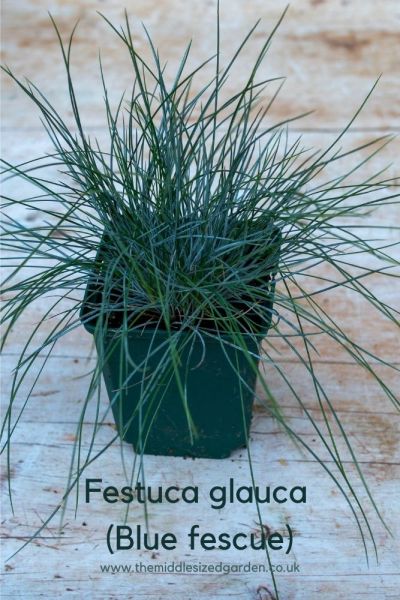
Blue fescue or Festuca glauca is a neat, blue-grey ‘grass’ to edge window boxes, hanging baskets or borders.
As soon as Jane spotted these blue Festuca glauca, she was inspired to add them to her window boxes and pots.
Gaultheria procumbens (American wintergreen)
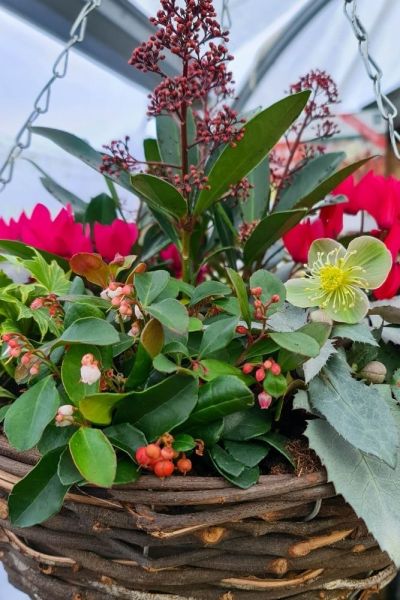
The red-berried Gaultheria procumbens (central in this photo) will plant out in your garden. It grows to only 30cm high and is easy care. The pink berried Gaultherias, however, will need a male/female plant to ensure pollination.
Hebes – many varieties and leaf colours.
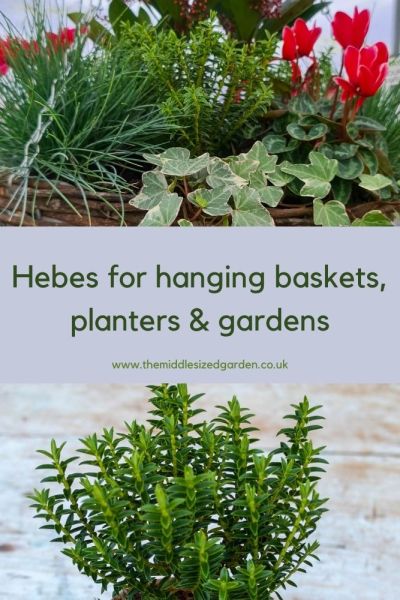
There are a huge range of hebe varieties so check which ones grow where you live. They add structure and evergreen colour to both borders and planters.
Hellebores – plant out after the first winter in a pot
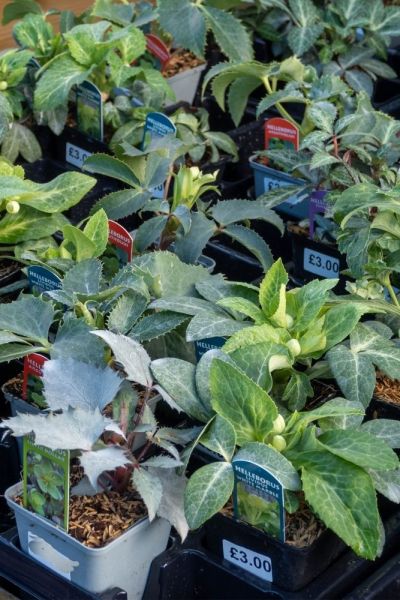
These evergreen hellebores are available in blue/green or bright green leaves, to tie in with your colour scheme. Hellebores are probably best planted out after just one winter in a pot, as hellebores are quite deep rooted plants and may find a pot constricting.
Jane chose the pale blue grey of Hellebore ‘Silver Dollar’ along with a similar shade of Festuca glauca for her pots and window boxes.
Heuchera – many varieties and leaf colours
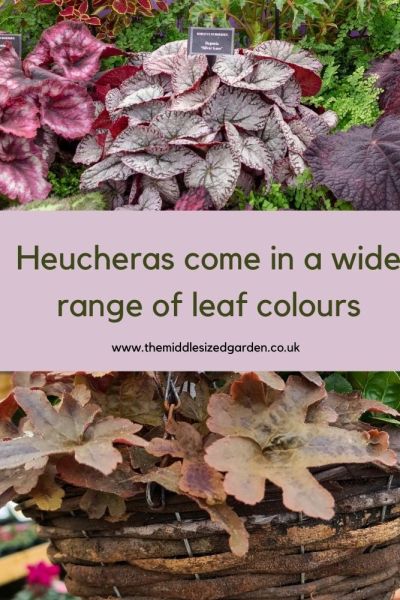
Heucheras now come in a wide variety of leaf colours and grow well in pots. But they seem particularly vulnerable to vine weevil, so if you see little white grubs in the potting compost, change all the soil immediately.
Holly – variegated hollies like ‘Golden King’ add structure to pots and gardens
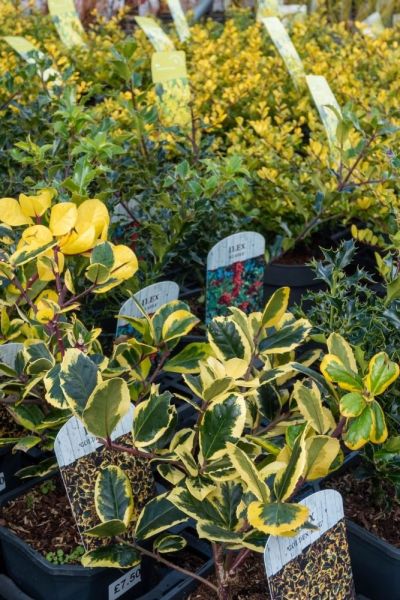
Ivy – trails in pots and climbs in the garden
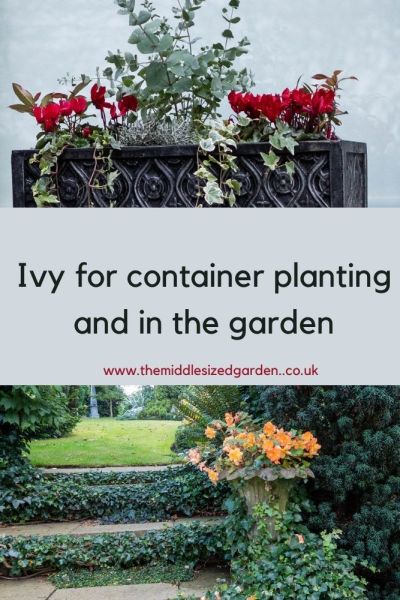
Ivy is a good trailing plant for pots and window boxes, and can be good ground cover or a climber in the garden. You will need to trim it at least once a year however. If ivy is left unchecked, it will continue to grow – everywhere! For a garden that uses evergreens such as ivy beautifully, see Roger Lloyd’s evergreen garden in Norfolk.
Leucothoe (eg Leucothoe ‘Scarletta’)
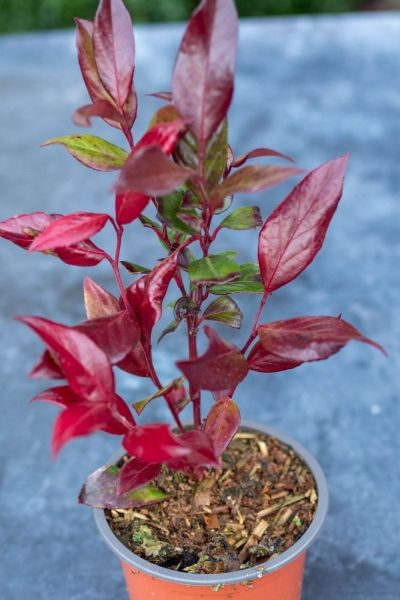
Leucothoe’s red leaves make it a popular choice for winter container gardens. It prefers acid soil, so if your soil is alkaline, you’ll have to keep it in a pot and feed it with ericaceous plant feed in summer.
Skimmia – low maintenance, easy-grow shrubs with good height
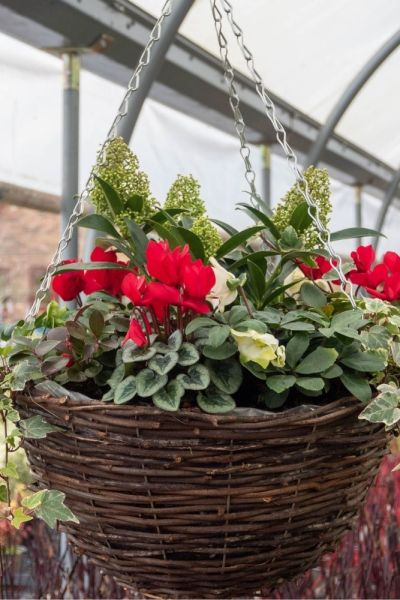
Several of the hanging baskets at Maytree Nursery featured skimmias as their central plant,. It adds height, colour and structure. Here a creamy white skimmia is partnered with red cyclamen, ivy and hellebores.
Skimmias work best in pots when they’re small plants. As they get bigger they need more space and nutrients. But they are very easy-care plants. They prefer partial shade in the garden. Many people think they need acid soil, but they don’t.
Skimmia are available in a wide range of colours. Although the picture above appears to show it in flower, these are actually buds, which are on the plant all winter. They’ll flower in spring, making skimmia a very useful presence in the garden.
When to plant a winter container garden
You can plant winter pots any time. Jane usually waits until her summer display is looking tired. This year there was a mild autumn, so the summer plants went on flowering until late November.
‘When I was working as a garden designer,’ says Jane, ‘I had clients who changed their pots and window boxes four times a year. So they’d have an autumn display from about late September onwards and then a winter one from the middle of December. You will find that the plants available in the shops change though.’
How to choose the right pots
You can plant a winter container garden in most kinds of planters. But if your winters are very cold, metal planters will get particularly cold, so you’ll need to check the hardiness of the plants you put in them. Terracotta pots must be frost-proof. Ceramic and resin planters are good too.
‘Self-watering plant pots’, such as those from Lechuza, take some of the guesswork out of watering and mean that you don’t have to water as often.
You can also recycle containers of various kinds to use as planters. The most important thing is to make sure that there are drainage holes in the base so that water can run out. Here are 25 pot and planter ideas for container gardens.
Can you re-use plants from one season to the next?
Jane did the basic structure of the current window boxes and front garden pots up to two years ago. She explains how to put together winter window boxes from scratch here. She re-did them the following winter, re-using most of the plants in some way. You can read her winter pots tips here.
(If you’d like to read the Middlesized Garden’s gardening tips, ideas and inspiration regularly, see here to get a free weekly email with all the posts.)
But now that the plants have been in for one or two years, she thinks it’s time for a change. The small conifers are getting too big, so she’s giving them to me.
Evergreens can often live in pots for several years, offering structure and year-round interest for very little attention. See 10 easy care evergreen pots for year-round impact for more evergreen container garden ideas.
How to water a container garden in winter
More container garden plants are killed by over-watering than by under-watering, especially in winter. It’s particularly important not to have winter pots sitting on saucers, for example, as the water can puddle at the base of the pot and freeze.
Unless your weather is very dry, you probably won’t have to water your winter pots and planters. Start watering in spring, when new foliage starts to appear. By then, your winter container gardens will probably need to be replaced by the spring or summer schemes. Some evergreen plants can stay in pots for a couple of years, however.
Should you feed winter container garden plants?
No. Most people don’t feed their winter containers. Some experts even say that feeding plants in pots, hanging baskets or planters in winter will encourage soft new growth which will then be vulnerable to frost.
All plants in pots need regular feeding and watering from about mid-spring to early autumn. I’ve used a number of good fertilisers for containers, such as Richard Jackson’s Flower Power Premium Plant Food and Envii Organic Seaweed Extract. Both were sent free for me to review, but I’d be happy to buy either. (note that Amazon links are affiliate, see disclosure.)
See 6 tips for brilliant container gardening here.
Pin to remember winter container garden tips
And do join us – see here for a free weekly email with more gardening tips, ideas and inspiration.
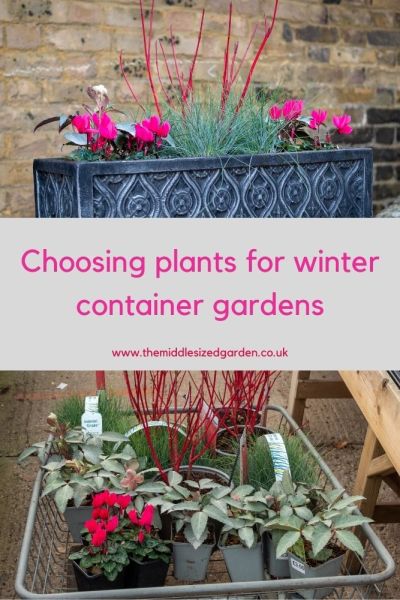
























Thank you once again for your video and all the plants you mention. Could I line a big pot with a fertiliser bag ( with holes) so I can take out the tulips and wee daffodils and let them die somewhere in the garden, leaving the pot free for spring and summer plants?
You can certainly take out the daffodils and tulips and add them to the garden, leaving the pot free. I’m not sure you’d need a bag in there. If you’re wondering how to access the bulbs, then just dig them out. If you’re swapping around the planters anyway, then it doesn’t matter that you dig up some potting compost – in fact you’ll need to change at least the top layer of potting compost for the spring and summer plants anyway. Hope that helps.